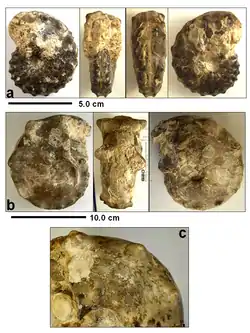Mammites
Mammites is a Late Cretaceous (Cenomanian to Turonian) ammonite genus included in the acanthoceratoidean family, Acanthoceratidae, and the type genus for the subfamily Mammitinae. Mammites was named by Laube and Bruder in 1887.[1][2]
| Mammites | |
|---|---|
 | |
| M. nodosoides fossil from Madagascar | |
| Scientific classification | |
| Kingdom: | Animalia |
| Phylum: | Mollusca |
| Class: | Cephalopoda |
| Subclass: | †Ammonoidea |
| Order: | †Ammonitida |
| Family: | †Acanthoceratidae |
| Subfamily: | †Mammitinae |
| Genus: | †Mammites Laube & Bruder, 1887 |
| Species | |
|
See text | |

a) juvenile; b) adult; c) sutural pattern
Species
Species within the genus Mammites include:[2]
- M. mohavanensis Böse, 1923 - found at Loma el Macho, Coahuila, Mexico
- M. mutabilis Reyment, 1955 - known from Cameroon
- M. nodosoides Schlüter, 1871 - found in North and South America, Africa and Europe
- M. powelli Kennedy et al., 1987 - found in Texas and Colombia
- M. rancheriae Anderson, 1958 - known from the North American Pacific region
Description
Shells of Mammites are typically stout, usually with a rectangular or squarish whorl section and flattish to slightly concave venter and can reach a diameter of 15–20 millimeters (0.59–0.79 in). Ornamentation is dominated by strong umbilical tubercles and moderate inner and outer ventrolateral tubercles. Ribs are somewhat prominent in juveniles stages but tend to become inconspicuous in the adult. The suture is ammonitic but rather simple. Some species, those with broad first lateral lobes in the suture, have been reassigned to Morrowites
Mammites and Morrowites are rather similar except that Mammites as redefined has a narrow first later lobe while that in Morrowites is broad and the early whorls in Morrowites are smooth except for widely spaced ribs and constrictions while those in Mammites have normal ribs and tubercles.
Distribution
Fossils of species within this genus have been found in the Late Cretaceous formations of Angola, Brazil, Cameroon, Colombia (La Frontera, Boyacá, Cundinamarca and Huila) and San Rafael Formations,[3][4] Egypt, France, India, Madagascar, Mexico, Nigeria, Peru, Romania, Tunisia, United States and Venezuela.[2]
References
- Sepkoski Online
- Mammites at Fossilworks.org
- Patarroyo, 2016, p.41
- Patarroyo & Rojas, 2007, pp.92-93
Bibliography
- Patarroyo, Pedro. 2016. Amonoideos y otros macrofósiles del lectoestratotipo de la Formación la Frontera, Turoniano inferior - medio (Cretácico Superior) en San Francisco, Cundinamarca (Colombia). Boletín de Geología, Universidad Industrial de Santander 38. 41-54. Accessed 2017-04-04.
- Patarroyo, Pedro, and Alexis Rojas. 2007. La sucesión y la fauna del Turoniano de la Formación San Rafael en Pesca y su comparación con la sección tipo en Samacá (Boyacá-Colombia-S.A.). Geología Colombiana, Universidad Nacional de Colombia 32. 89-96. Accessed 2017-04-05.)
Further reading
- Arkell, W.J.; W.M. Furnish; Bernhard Kummel; A.K. Miller; R.C. Moore; O.H. Schindewolf; P.C. Sylvester-Bradley, and C.W. Wright. 1957. Mesozoic Ammonoidea, Treatise on Invertebrate Paleontology, 1-490. Part L; Geological Society of America and University of Kansas Press.
- W.A. Cobban; Hook, S.C. (1983). "Mid-Cretaceous (Turonian) ammonite fauna from Fence Lake area of west-central New Mexico". Memoir. New Mexico Bureau of Mines & Mineral Resources, Socorro NM. 41.
- W.A. Cobban; Hook, S.C. (1979). "Collignoniceras woollgari woollgari (Mantell) ammonite fauna from Upper Cretaceous of Western Interior, United States". Memoir. New Mexico Bureau of Mines & Mineral Resources, Socorro NM. 38.
